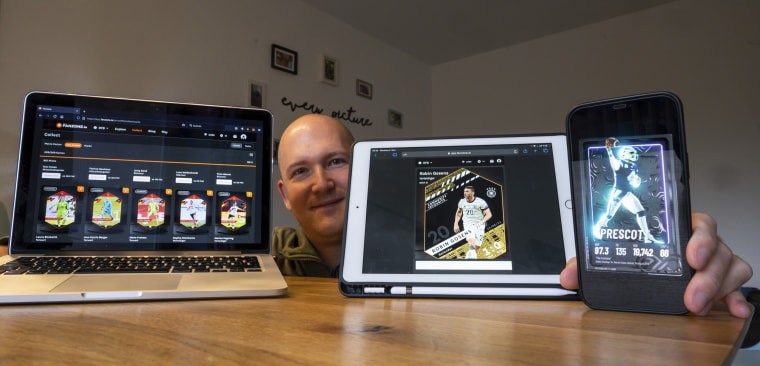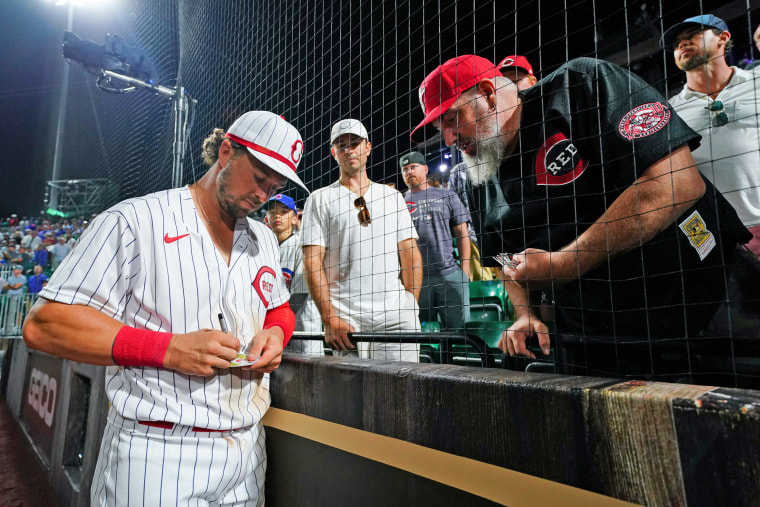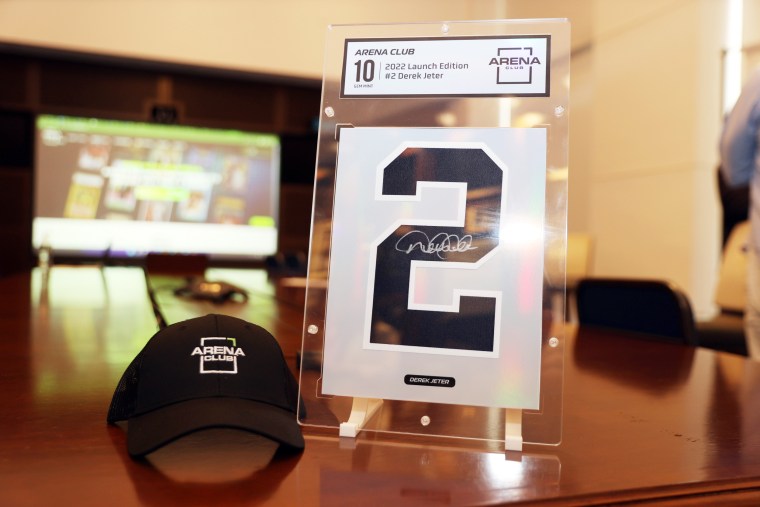In the sports collectibles world, cardboard is still king — for now.
Despite the boom and subsequent semi-bust of digital sports collectibles in the past couple of years, the world of tangible sports collectibles — cards, jerseys, memorabilia and all things in between — has remained hot. The record for most ever paid for sports memorabilia has been broken three times this year, though prices for some popular cards have dipped from their peaks in 2020 and 2021.
That market has been boosted by a thriving online content industry surrounding sports cards and memorabilia. Dozens of YouTube channels, podcasts and TikTok accounts track the market, with some offering a way for people to purchase cards, jerseys and even autographed football helmets.
That’s fueled some optimism that NFTs, or non-fungible tokens (blockchain-based tokens tied to digital art) aren’t set to replace the thrill of opening a pack of cards anytime soon.
“I would say the future is 100% tangible,” said Mike Heffner, CEO of Lelands, a sports auction house that approaches $50 million in revenue a year. “With an NFT, I don’t understand it; I just don’t see how that can bring the same thrill to someone.”
Sports NFTs did have their moment. Sales soared during the pandemic, and Deloitte Global projected that they would generate $2 billion in U.S. transactions this year, almost double that of 2021. But amid a crypto winter, the future trajectory of the sports memorabilia market, tangible or NFT, is being disputed.

Heffner said his company has attempted a couple of NFT deals that didn’t work out and now exclusively does tangible item auctions. He doesn’t plan to head into the NFT space anytime soon.
The trading card resurgence quickly built upon itself at the start of the pandemic. With live sports stalled, many restless sports fans nostalgically searched their attics to check in on the value of a past hobby. Stirred by viral TikTok and YouTube videos of collectors opening packs of valuable cards, some dusted off well-conditioned cards that sold for thousands of dollars, and a few for millions.
One of the largest auction houses for sports memorabilia, Goldin Auctions, raked in $100 million in 2020 sales and more than triple that in 2021.
Meanwhile, the success of NBA Top Shot, arguably the most successful sports NFT market, soared and eventually crashed. The platform — run by Dapper Labs, a blockchain startup that has raised hundreds of millions of dollars in funding — boasted around 180,000 unique buyers in March 2021, according to data from NFT tracker CryptoSlam. In August 2022, that number dipped to less than 10,000 buyers. The prices of Top Shot NFTs followed a similar trajectory.
“Much like crypto, sports NFTs were driven by so much concern over money and value,” said Darren Rovell, a sports business reporter for Action Network and devoted sports ticket collector.
There was the initial cultural and internet craze for sports NFTs, but love for the item kept the tangible market thriving, and that is where the focus is now, Rovell said.
“I’m just not convinced that there was a lot of enjoyment with [NFTs],” he said.

Some collectors saw tangible assets as a more stable financial investment than their digital analogs.
“The tangible pieces continue to hold strong, hold their value, even rise in value, while the NFT market has pulled back quite significantly,” said Chris Ivy, president and founder of the sports division of Heritage Auctions, who oversaw the record-breaking $12.6 million sale of a Mickey Mantle baseball card in August.
There’s a place for NFTs in the market, but it’s with a new type of collector, said Ivy, who has been with Heritage Auctions for 22 years. “Traditional collectors want the tangible item,” he said.
Millennials are driving the NFT market, according to a Morning Consult survey that found 42% of all NFT collectors are 26 to 40 years old.
Some are still keen to capitalize on the NFT sports market and view it as the future of sports memorabilia sales due in part to the endorsement of all-star athletes.
In September, baseball Hall of Famer Derek Jeter launched Arena Club, a sports card collecting company that attempts to bridge the physical and digital sports card spaces by allowing users to send in their cards to be represented in a personalized digital showroom.

NFL quarterback Tom Brady, who last year co-founded Autograph — a sports NFT company that gives users the chance to purchase digital assets that have been signed by athletes like LeBron James and Steph Curry, and even nonsports celebrities like Quentin Tarantino and Paris Hilton — launched a fan club experience last month that gives digital token owners access to exclusive watch parties and a chance to meet Brady himself.
“Sports and NFTs just make sense as a combination,” said Ethan McMahon, an economist at Chainalysis, a company that monitors blockchain data. “There’s just so much that can be done with digital technology … not only ownership, but membership, and that’s just something the tangible side doesn’t offer you.”
McMahon said the drop-off in transaction volume of sports NFTs was proportionally less than the entire NFT market experienced during the crypto winter. He estimated that revenue of sports NFTs is currently around $50 million per month and has been consistent since November 2021.
Much of the issue is maturity of the market, McMahon said. NFT collections will often launch with skyrocketing sales that later fizzle down to more standard price points.
“A collection may have a hot start but it’s hard to have a sustained level of activity, but that’s not to say the activity isn’t happening in other places within sports,” he said.
Some sports market experts argue that regardless of an NFT bounce back, tangibles and NFTs in the sports memorabilia market don’t compete with each other.
“I don’t think that [NFTs] are going to eat into the physical memorabilia market,” said Pete Giorgio, leader of Deloitte Consulting’s global and U.S. sports practice, who tracks and forecasts the sports memorabilia market. “The person who is buying an NFT is not necessarily the person who is buying Michael Jordan’s game-worn jersey.”
Like many attempting to forecast what is to come, Giorgio predicted that the future of sports memorabilia is likely made up of both markets.
“I do think it will still be a mix,” he said. “I do think the tangible and digital will both play a part in it.”
